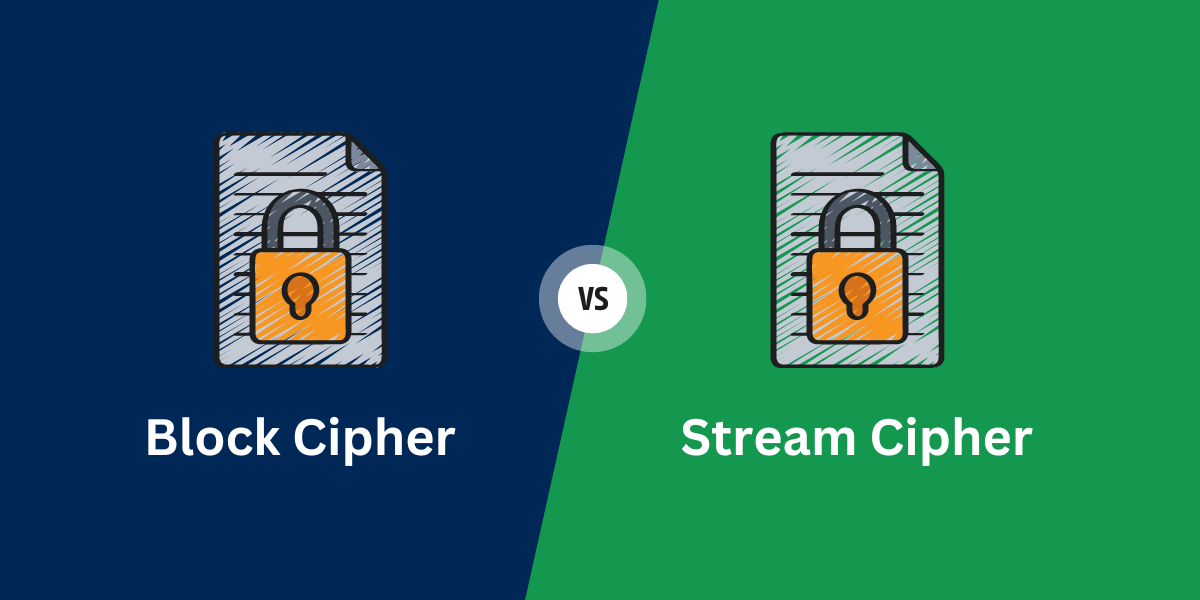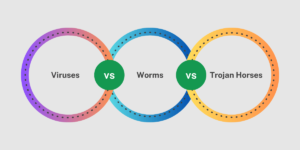What are the Difference Between Block Cipher and Stream Cipher?
Cryptography is a critical component of modern digital security, and the choice between block ciphers and stream ciphers is a fundamental consideration. Block Cipher vs Stream Cipher are two distinct approaches to encrypting data, each with its own advantages and use cases.
Understanding the differences between these two encryption methods is essential for selecting the appropriate algorithm for a given application. This article will explore the key distinctions between block ciphers and stream ciphers, examining their underlying principles, performance characteristics, and the scenarios in which one may be preferred over the other.
Key Takeaways
- Block ciphers encrypt fixed-size blocks of plaintext at a time, while stream ciphers encrypt continuous streams of plaintext one bit or byte at a time.
- Block ciphers like AES are used in protocols like SSL/TLS, while stream ciphers like RC4 have uses in securing wireless communications.
- Block ciphers can operate in different modes, such as ECB, CBC, and CTR, which impact their security and use cases.
- Stream ciphers aim to emulate the secrecy of a one-time pad through pseudorandom keystream generation.
- Block ciphers can suffer from ECB and padding Oracle attacks, while stream ciphers are vulnerable to nonce reuse and related key attacks.
- Performance, flexibility, and susceptibility to cryptanalysis are some key factors in choosing between block vs stream ciphers.
A Head to Head Comparison Between Block Cipher vs Stream Cipher
| Feature | Block Ciphers | Stream Ciphers |
| Encryption Units | Fixed size blocks (64 or 128 bits typically) | Individual bits or bytes |
| Encryption Process | Mathematical operations on substitution, permutation over rounds | Pseudorandom keystream generation and XOR with plaintext |
| Modes of Operation | ECB, CBC, CTR etc. impact security, performance | N/A |
| State Requirements | Limited block cipher state | Extensive state for keystream generation |
| Determinism | Fully deterministic | Pseudorandom keystream |
| Error Propagation | Yes in CBC and other modes | No error propagation |
| Padding Requirements | Yes, to fill up partial blocks | No padding required |
| Parallelization | Partial, some modes allow parallel decryption | Intrinsically serial process |
| Hardware Efficiency | Requires more memory and logic | Low memory, efficient implementations |
| Typical Use Cases | Disk encryption, transport security protocols, cryptocurrencies | Wireless communications, embedded systems, high throughput applications |
How Block Ciphers Work
Block ciphers are symmetric key algorithms that break up plaintext into fixed-size blocks (often 64 or 128 bits) and encrypt one block at a time. For example, AES operates on 128-bit blocks.
The encryption process uses a secret key and well-defined mathematical operations to transform each plaintext block into an encrypted ciphertext block. Decryption reverses this process, using the same key to recover the original plaintext.
A simple example is the Data Encryption Standard (DES), which uses 64-bit blocks. Here’s a simplified overview of how it works:
- The plaintext is divided into 64-bit blocks. If needed, padding is added to the final block.
- Each block is passed through 16 rounds of mathematical operations involving permutation, substitution, and XORing with subkeys derived from the main 56-bit key.
- This scrambles the block contents to produce a 64-bit ciphertext block which bears no discernible relationship to the plaintext.
- The process repeats for each block, using the same key but different subkey derivations.
- Decryption applies the inverse operations in reverse order using the same subkeys.
This step-by-step encryption and reversible decryption make block ciphers useful for securely storing data at rest or transmitting it over communications links.
Block Cipher Modes of Operation
A key aspect of block ciphers is their mode of operation, which defines how multiple blocks are handled. The mode impacts both security and performance.
Common modes include:
- Electronic Codebook (ECB): Each block is encrypted independently using the secret key. Identical plaintext blocks produce identical ciphertext blocks. This method is simple but insecure for most uses.
- Cipher Block Chaining (CBC): Before encryption, each block is XORed with the previous ciphertext block. This method chains blocks together to hide patterns, but it needs an initialization vector (IV).
- Output Feedback (OFB): Repeatedly encrypts IV to generate a keystream, which is XORed with plaintext. Streams cipher-like mode without error propagation.
- Counter (CTR): Uses sequential counter block values encrypted with the key to produce a keystream. Parallelizable encryption and decryption.
- Galois/Counter Mode (GCM): Parallelizable encryption using a counter combined with Galois authentication for integrity. It is popular in IPsec and TLS.
Proper mode selection prevents security pitfalls like ECB’s block repetition and allows customizing block ciphers for performance.
How Stream Ciphers Work
Stream ciphers take a radically different approach. Instead of encrypting individual blocks, they generate a continuous stream of pseudorandom bits (the keystream) which is XORed with the plaintext stream one bit or byte at a time.
The sender and receiver must stay synchronized to align the keystream with the plaintext. Typically, the keystream depends on the following:
- A secret key
- An initialization vector (IV) or nonce
- Previous keystream bits/bytes
Unlike block ciphers, stream ciphers operate on streaming data of arbitrary length. Their encryption process looks like this:
- Initialize the cipher state using the key and IV/nonce.
- Generate the keystream, one bit/byte at a time, by iteratively updating the state.
- XOR each keystream bit/byte with the matching plaintext bit/byte to produce the ciphertext.
- To decrypt, reinitialize the cipher state, regenerate the keystream, and XOR it with the ciphertext.
If implemented well, the keystream appears truly random and one-time to an attacker. This approximates the theoretical secrecy of a one-time pad cipher.
Examples of Stream Ciphers
Some widely used stream ciphers include:
- RC4: Simple design based on a PRNG but has weaknesses in real-world usage. Used in WEP/WPA wi-fi security.
- ChaCha20: Improved eSTREAM cipher using a linear feedback shift register, chaotic state mixing, and 64-bit nonce. Part of TLS and IPSec VPNs.
- Salsa20: Variant of ChaCha20 with a 128-bit nonce. Known for speed in software implementations.
- CipherSaber: Uses finite field arithmetic like GCM authenticated encryption. Part of Bluetooth Low Energy’s encryption.
- HC-128: Designed for speed in software using linear feedback shift registers and a large key/IV.
Stream ciphers like these excel in hardware efficiency and minimizing error propagation but have challenges regarding keystream reuse compared to block ciphers.
Key Differences Between Block Cipher and Stream Cipher
With the basics covered, let’s compare some of the key differences between block ciphers and stream ciphers:
- Encryption units: Blocks of fixed size vs individual stream bits/bytes.
- State: Block ciphers have limited state while stream ciphers maintain extensive state for keystream generation.
- Determinism: Block ciphers are fully deterministic, and stream ciphers involve pseudorandom generation.
- Error propagation: Block cipher modes like CBC propagate errors while stream ciphers do not.
- Padding: Block ciphers often require padding plaintext to block size; stream ciphers have no such need.
- Parallelization: Block encryption is sequential, but some modes allow parallel decryption. Stream ciphers are intrinsically serial.
- Hardware efficiency: Stream ciphers have lower memory requirements and efficient hardware implementations.
- Cryptanalysis: Block ciphers rely more on diffusion/confusion, and stream ciphers depend on keystream randomness.
Understanding these differences helps select the right cipher for particular use cases and requirements. Neither has a blanket advantage on security or performance.
Typical Use Cases and Applications
The typical applications for block ciphers versus stream ciphers depend on their respective strengths:
Block Ciphers
- Disk encryption: This is widely used in full disk encryption tools like BitLocker and VeraCrypt for their block handling and efficiency with stored data.
- Transport encryption protocols, such as TLS, SSL, and IPsec, use block ciphers like AES in modes like GCM to encrypt communications.
- Cryptocurrencies: Blockchains rely on block ciphers like AES for secure yet efficient encryption and hash functions.
- Password hashing: Key derivation functions use block ciphers like AES or algorithms like Scrypt to generate secure password hashes.
- Random number generation: Modes like CTR-DRBG leverage block ciphers to generate cryptographically random bits.
Stream Ciphers
- Wireless communications: Used historically in WEP and WPA security protocols to encrypt wireless traffic in a low latency manner.
- Hardware efficient environments: Better suited for encryption in constrained environments like embedded devices and IoT networks.
- Low error propagation: More resilient in noisy transmission environments where errors can’t be tolerated.
- High-throughput applications: Some stream ciphers provide very fast and simple encryption to keep up with high data volumes.
The split highlights how block ciphers are favored for storage, complex protocols, and randomness, while stream ciphers meet different performance and error resilience needs.
Security Considerations for Block vs Stream Ciphers
Both block ciphers and stream ciphers rely on the secrecy of the key and sound mathematical principles to provide confidentiality and prevent cryptanalysis.
However, they aren’t free from all security risks.
Vulnerabilities of Block Ciphers
- Weak block modes: ECB mode leaks data patterns. But chaining modes like CBC have IV risks.
- Padding oracle attacks: Errors due to improper padding may expose data via side channels.
- Multi-target attacks: Targeting identical blocks across files can break semantic security.
- Weak keys: Some block ciphers have structural weaknesses around certain key values.
- Inadequate subkeys: Shorter subkeys generated from the main key limit minimum security.
- Cryptanalysis: Attacks like differential, linear, and algebraic can break flawed block ciphers.
Vulnerabilities of Stream Ciphers
- Keystream reuse: Major risk if IV/nonce is repeated or keystream isn’t discarded after use.
- Weak or correlated keys: Attacker guessing keys means broken randomness and cipher.
- Periodicity: Ciphers with repeating keystream patterns are trivially breakable.
- Algebraic weaknesses: Susceptibility to attacks using techniques like lattices and interpolation.
- Correlated internal state: Insufficient mixing of internal state leads to key recovery attacks.
- Initialization weaknesses: Poor initialization can lead to a range of possible exploits.
Performance and Efficiency Comparison
Depending on exact algorithms and implementations, block ciphers and stream ciphers can have significant performance differences:
- Throughput: Stream ciphers excel at high-speed encrypted throughput with simplicity. Block cipher throughput depends on factors like mode, padding, and acceleration.
- Latency: Stream ciphers have lower per-bit latency, while block ciphers process one block at a time.
- Parallelism: Stream ciphers are intrinsically serial. Block ciphers are parallelizable in some modes but not all.
- Hardware costs: Stream ciphers require less memory and simpler logic for efficient hardware implementation.
- Error propagation: Block cipher modes like CBC propagate errors. Stream ciphers avoid this by design.
- Packet overhead: Block ciphers need padding to block size. Stream ciphers have negligible overhead for most protocols.
For performance-critical applications, benchmarks of throughput, latency and CPU utilization are essential to compare options.
Should You Choose a Block Cipher or a Stream Cipher?
There is no universally superior cipher between block and stream designs. Here are some key considerations when choosing between them:
- Analyze the use case requirements: error tolerance, hardware constraints, confidentiality needs, and speed.
- Match the block length to the application: shorter for constrained environments and longer for high security.
- For block ciphers, choose a mode appropriate for the use case: CBC for storage and CTR for parallelism.
- Lean towards stream ciphers when hardware efficiency, low latency, and throughput are critical.
- Prefer block ciphers when strong authentication, mainstream protocol support, and standardization are needed.
- Understand the cryptographic primitives they rely on: ARX vs LFSR, SP-Networks, AES S-box, etc.
- Compare resistance to cryptanalysis based on existing literature and margins of safety.
- Ensure proper key management, randomness, and usage policies to avoid fundamental exploitation.
Both cipher designs can provide robust security and performance if they are avoided. The optimal choice depends on balancing these factors for the specific use case.
Final Thoughts
While block ciphers and stream ciphers take fundamentally different approaches, encryption primitives play important roles in securing data. Block ciphers provide versatile standard building blocks for widespread protocols and applications using modes like CBC, CTR, and GCM. Stream ciphers meet specialized needs for performance, error tolerance, and constrained environments.
By understanding their core differences in the encryption process, cryptographic soundness, vulnerabilities, use cases, and performance, engineers can sensibly choose between block and stream ciphers based on their specific security and systems requirements. With proper algorithm selection, implementation, and key management, both offer robust solutions for protecting confidentiality in the digital world.
Frequently Asked Questions
Are block ciphers more secure than stream ciphers, or vice versa?
Neither block ciphers nor stream ciphers are inherently more secure. Both rely on sound cryptographic principles and can achieve high security when used correctly. However, they have different vulnerabilities that must be mitigated in usage and protocol design.
Can block ciphers be used for stream encryption?
Yes, block cipher modes like CTR transform a block cipher into a stream cipher by generating a keystream from sequential counter blocks. Other stream-cipher-like modes are OFB and GCM.
Do stream ciphers need padding?
No, stream ciphers operate on the plaintext stream bit-by-bit or byte-by-byte, so no padding is required. Block ciphers need padding schemes to fill partial blocks.
What are some examples of strong block ciphers?
AES, Blowfish, Twofish, Serpent, CAST-256, and Camellia have widely analyzed block ciphers considered secure when used properly. AES is the most prominent and standardized.
What are some examples of strong stream ciphers?
ChaCha20, Salsa20, and eSTREAM portfolio ciphers like HC-128 are designed to withstand cryptanalysis. RC4 is historic but has weaknesses in practice.
Can the same key be reused securely for different data with block vs stream ciphers?
Block ciphers like AES are designed for secure reuse with different data. For stream ciphers, reuse risks keystream repetition, which breaks security entirely.

Priya Mervana
 Verified Web Security Experts
Verified Web Security Experts
Priya Mervana is working at SSLInsights.com as a web security expert with over 10 years of experience writing about encryption, SSL certificates, and online privacy. She aims to make complex security topics easily understandable for everyday internet users.



